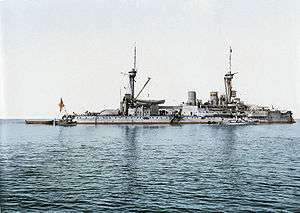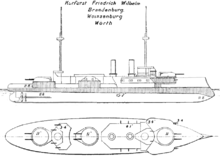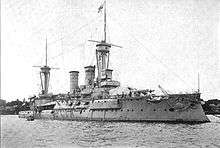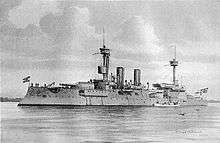Brandenburg-class battleship
 SMS Kurfürst Friedrich Wilhelm | |
| Class overview | |
|---|---|
| Operators: | |
| Succeeded by: | Kaiser Friedrich III-class battleship |
| Built: | 1890—94 |
| In commission: | 1893—1938 |
| Completed: | 4 |
| Lost: | 1 |
| Scrapped: | 3 |
| General characteristics | |
| Type: | Battleship |
| Displacement: | 10,013 t (9,855 long tons) |
| Length: | 115.7 m (379 ft 7 in) |
| Beam: | 19.5 m (64 ft 0 in) |
| Draft: | 7.6 m (24 ft 11 in) |
| Propulsion: |
|
| Speed: | 17 knots (31 km/h; 20 mph) |
| Range: | 4,500 nmi (8,300 km; 5,200 mi) at 10 knots (19 km/h; 12 mph) |
| Complement: | 568 |
| Armament: |
|
| Armor: | |
The four Brandenburg-class pre-dreadnought battleships were Germany's first ocean-going battleships. They were also the first German warship, of any type, to be fitted with wireless communications. The class comprised Brandenburg, Kurfürst Friedrich Wilhelm, Weissenburg, and Wörth. All were laid down in 1890 and completed by 1893, except for Weissenburg, which was completed in 1894. The lead ship, Brandenburg, was built at the cost of 9.3 million Marks and Kurfürst Friedrich Wilhelm cost 11.23 million Marks.[1] The British Royal Navy derisively referred to the ships as the "whalers."[2]
Brandenburg and her three sisters served in a wide range of roles. In 1900, the four ships were deployed to China during the Boxer Rebellion, after which they were substantially modernized. In 1910, two of the ships, Kurfürst Friedrich Wilhelm and Weissenburg, were sold to the Ottoman Navy. Kurfürst Friedrich Wilhelm was sunk in 1915 by a British submarine while Weissenburg survived the war, only to be broken up in 1938. Brandenburg and Wörth saw limited service during World War I as coastal defense ships before they were withdrawn for auxiliary duties. Both ships were sold for scrapping in May 1919.
Design
The Brandenburg-class ships were the first ocean-going battleships built by the German Navy. They followed a number of coastal defense ships, including the Siegfried and Odin classes that were only intended for local defense of the German coastline.[2] Design work on the ships began in late 1888, under the leadership of Vice Admiral Alexander von Monts, who also secured funding for the new ships from the Reichstag. Admiral von Monts was the first naval officer appointed by the recently crowned Kaiser Wilhelm II.[3]
The Brandenburg-class ships were the foundation of what eventually became the High Seas Fleet. As they represented a shift in the strategic outlook of the German navy, the traditional method of ship construction, which relied heavily on foreign models, was abandoned. Some experimentation was implemented in the design process, particularly in the armor types that were installed on the ships. Brandenburg and Wörth were equipped with compound armor that consisted of several layers of different materials, while the latter two ships received Harvey nickel-steel alloy armor plating.[4] The addition of a third main battery turret was also a significant innovation. While a novel concept, the midships turret caused prohibitive blast damage to the surrounding superstructure when fired, which led to the idea being abandoned. This arrangement has led some authors to characterize the ships as proto-dreadnoughts. This is incorrect, as the guns were not the same caliber, and the ships were designed to fight at close range, unlike the later dreadnought battleships.[2]
General characteristics
The ships of the Brandenburg-class were 113.9 m (373 ft 8 in) long at the waterline and 115.7 m (379 ft 7 in) long overall. They had a beam of 19.5 m (64 ft) which was increased to 19.74 m (64 ft 9 in) with the addition of torpedo nets, and had a draft of 7.6 m (24 ft 11 in) forward and 7.9 m (25 ft 11 in) aft. The Brandenburgs displaced 10,013 t (9,855 long tons) at their designed weight, and up to 10,670 t (10,500 long tons) at full combat load.[5]
As was the standard for German warships of the period, the hulls of the Brandenburg-class ships were constructed from both transverse and longitudinal steel frames, over which the steel side plates were riveted. The vessels had 13 watertight compartments and a double bottom that ran for 48 percent of the length of the hull. The German navy regarded the ships as excellent sea-boats; the Brandenburgs had easy motion. They were also responsive to commands from the bridge and had a moderate turning circle. Speed loss at hard rudder was reduced to 30 percent, and the metacentric height was 1.05 m (3 ft 5 in). However, the ships were "wet" at high speeds and suffered from severe pitching.[5] The ships' crew numbered 38 officers and 530 enlisted men, though while serving as the squadron flagship the standard crew was augmented by an additional 9 officers and 54 men.[6]
Machinery
The ships were equipped with two sets of 3-cylinder triple-expansion engines; each set drove a 3-bladed screw that was 5 m (16 ft) in diameter. Both sets had their own engine room. Twelve transverse cylindrical boilers, with three fireboxes each, supplied steam to the engines at up to 12 atmospheres of pressure. The boilers were also divided into two boiler rooms. The engines were rated at 10,000 ihp (7,500 kW), though in practice maximum power ranged from 9,686 ihp (7,223 kW) for Kurfürst Friedrich Wilhelm to 10,228 ihp (7,627 kW) in Wörth. The ships had a designed speed of 16.5 knots (30.6 km/h; 19.0 mph); Brandenburg was the slowest, at 16.3 knots (30.2 km/h; 18.8 mph), while Kurfürst Friedrich Wilhelm and Wörth both achieved 16.9 knots (31.3 km/h; 19.4 mph) on trials. The ships were designed to carry 650 t (640 long tons) of coal for the boilers, though additional spaces in the hull allowed for up to 1,050 t (1,030 long tons). This enabled a maximum range of 4,300 nautical miles (8,000 km; 4,900 mi) at a cruising speed of 10 knots (19 km/h; 12 mph). Electrical power was provided by three generators. The equipment varied from ship to ship; power output ranged from 72.6 to 96.5 kilowatts at 67 volts. The ships each had a single rudder.[5]
Armament

The vessels were unusual for their time in possessing a broadside of six heavy guns in three twin gun turrets, rather than the four guns typical of contemporary battleships.[2] The forward and after turret carried 28 cm (11 inch) K L/40 guns,[lower-alpha 1] while the center turret carried a shorter L/35 barrel.[5] The shorter barrels were required to allow the turret to train from side to side.[2] The L/40 guns were mounted in Drh.L. C/92 type turrets, which provided depression to −5 degrees and elevation to 25 degrees. Both types of guns could fire armor-piercing (AP) and high explosive (HE) shells. These shells weighed 240 kg (529 lb), and used the 73 kg (161 lb) RPC 12 propellant charge. Muzzle velocity for the L/40 gun was 820 meters per second (2,690 fps). At maximum elevation, these guns could hit targets out to 15,900 m (17,400 yards).[7] Because the barrels of the L/35 guns were shorter, they had a correspondingly lower muzzle velocity, which was approximately 685 mps (2,247 fps). As a result, the range of the guns was somewhat shorter, at about 14,400 m (15,700 yd).[8] At a range of 12,000 m (13,000 yd), the AP shell could penetrate up to 160 mm (6.3 in) of belt armor.[7] Ammunition magazines stored a total of 352 shells.[5]
The Brandenburg class's secondary armament initially consisted of seven 10.5 cm (4.1 in) SK L/35 quick-firing guns[5] in casemates arranged around the forward superstructure. During the modernization between 1902 and 1904, the Brandenburgs received an additional 10.5 cm gun.[2] These guns were supplied with a total of 600 rounds, although after the modernization, the 10.5 cm magazines were increased to provide storage for a total of 1,184 shells.[5]
The ships also carried eight 8.8 cm (3.45 in) SK L/30 quick-firing guns,[5] also mounted in casemates. Four were placed in pairs in sponsons towards the bow, while the remaining four were emplaced around the rear superstructure.[2] These guns were supplied with a total of 2,000 shells, though as with the 10.5 cm guns, ammunition storage was increased during the modernization, to 2,384 rounds.[5] These guns fired 13.8 kg (30.4 lb) at a muzzle velocity of 590 mps (1,936 fps). Their rate of fire was approximately 15 shells per minute; the guns could engage targets out to 10,500 m (11,500 yd). The gun mounts were manually operated.[9]
The ships were also armed with six 45 cm torpedo tubes, all in above-water swivel mounts. Four tubes were mounted on the sides of the ship, another in the bow, and the last in the stern. The tubes were supplied with a total of 16 torpedoes.[5] These weapons were 5.1 m (201 in) long and carried an 87.5 kg (193 lb) TNT warhead. They could be set at two speeds for different ranges. At 26 knots (48 km/h; 30 mph), the torpedoes had a range of 800 m (870 yd). At an increased speed of 32 knots (59 km/h; 37 mph), the range was reduced to 500 m (550 yd).[10] One of the tubes was removed during the modernization.[2]
Armor
Weissenburg and Kurfürst Friedrich Wilhelm were armored with nickel steel Krupp armor, but due to delivery problems, Brandenburg and Wörth were armored with a composite armor. The composite armor was constructed by layering steel-clad wrought iron plates and wood planks, which was backed by two more layers of sheet iron. Krupp's nickel steel armor was based on the Harvey process, which enriched the upper layers of the steel with carbon. This type of armor produced greater strength with thinner armor belts, which enabled ships equipped with it to carry more complete protection.[4] Some portions of Brandenburg did receive the new Krupp armor, including the barbettes that held the fore and center main battery turrets. All four ships retained teak backing to their armor belts.[5]
The Brandenburgs had a 60 mm (2.4 in) thick armored deck. The forward conning tower had 300 mm (12 in) thick sides and a 30 mm (1.2 in) thick roof. Above the waterline, the armored belt was 400 mm (16 in) in the central portion of the ship and tapered slightly to 300 mm fore and aft. Including the teak backing, the total thickness of the belt in the strongest area was 600 mm (24 in). Below the waterline, the armored belt was significantly thinner; the thickest section of the belt was 200 mm (7.9 in) thick, and tapered down to 180 mm (7.1 in) on either end of the belt. The ships' cupolas had 50 mm (2.0 in) thick roofs and sides that consisted of three 40 mm (1.6 in) thick layers, for a total of 120 mm (4.7 in). The barbettes were 300 mm thick and backed with 210 mm (8.3 in) of wood.[5]
Construction

Ordered as battleship A,[5][lower-alpha 2] Brandenburg was laid down at the AG Vulcan shipyard in Stettin in 1890. She was launched on 21 September 1891. Fitting out work, which included the installation of the ship's armament, lasted until 19 November 1893 when she was commissioned into the German navy.[11] Wörth was ordered as battleship B,[5] and was laid down at Germaniawerft in Kiel also in 1890. Initial work on the ship proceeded the slowest of all four vessels of the class; she was launched on 6 August 1892. Fitting out work proceeded quickly, and she was commissioned on 31 October 1893, the first ship of the class to enter active duty.[11] Weissenburg, ordered as battleship "C", was also laid down at the AG Vulcan shipyard in 1890 and launched on 14 December 1891. She was the last ship of the class to enter active service, when she was commissioned on 5 June 1894.[11] Kurfürst Friedrich Wilhelm was the fourth and final ship of the class. She was ordered as battleship D,[5] and was laid down at the Kaiserliche Werft Wilhelmshaven in 1890. She was the first ship of the class to be launched, on 30 June 1891. She was commissioned into the fleet the same day as her sister Brandenburg.[11]
Shortly after the turn of the century, the ships were all taken into the drydocks at the Kaiserliche Werft Wilhelmshaven for a major reconstruction. Wörth was the first to do so, starting in 1901. Weissenburg followed in 1902, Brandenburg in 1903, and Kurfürst Friedrich Wilhelm entered the shipyard in 1904.[5] During the modernization, a second conning tower was added in the aft superstructure, along with a gangway.[12] The ships had their boilers replaced with newer models, and also had the hamper amidships reduced.[2] The modifications resulted in a weight decrease of between 500 t (490 long tons; 550 short tons) and 700 t (690 long tons; 770 short tons) depending on the ship.[12]
Service history

The ships of the Brandenburg-class were assigned to the I Division of the I Battle Squadron upon their commissioning,[13] along with the four older Sachsen-class armored frigates, though by 1901–2, the Sachsens were replaced by the new Kaiser Friedrich III-class battleships.[14] They saw their first major operation in 1900, when they were deployed to China during the Boxer Rebellion.[2] The expeditionary force consisted of the four Brandenburgs, six cruisers, 10 freighters, three torpedo boats, and six regiments of marines, under the command of Marshal Alfred von Waldersee.[15] Admiral Alfred von Tirpitz opposed the plan, which he saw as unnecessary and costly. The force arrived in China after the siege of Peking had already been lifted. As a result, the task force suppressed local uprisings around Kiaochow. In the end, the operation cost the German government more than 100 million marks.[16]
After the Brandenburg-class ships emerged from their refit in 1905, they rejoined the active fleet. However, they were rapidly made obsolete by the launch of HMS Dreadnought in 1906. As a result, their service careers were limited.[2] On 12 September 1910, Kurfürst Friedrich Wilhelm and Weissenburg, the more advanced ships of the class, were sold to the Ottoman Empire and renamed Barbaros Hayreddin and Turgut Reis respectively.[12] At the outbreak of World War I in 1914, Brandenburg and Wörth were assigned to coastal defense duties, though this lasted only until 1915, when they were withdrawn from active service. That year, both ships were transferred to the role of barracks ships; Brandenburg was stationed in Libau while Wörth was in Danzig.[2] It was intended to rebuild Brandenburg as a target ship, though this plan was eventually abandoned. Both Brandenburg and Wörth were struck from the naval register on 13 May 1919 and sold for scrapping.[13] The two ships were purchased by Norddeutsche Tiefbauges, a shipbreaking firm headquartered in Berlin; the firm had Brandenburg towed to Danzig where she and her sister ship were broken up for scrap.[12]
On 8 August 1915, Barbaros Hayreddin was en route to support the Turkish defenses at the Dardanelles when she was sunk by the British submarine HMS E11,[17] with the loss of 253 men.[2] On 19 January 1918, the battlecruiser SMS Goeben and light cruiser SMS Breslau left the Dardanelles to attack British ships. At 11:30, Goeben ran aground and was subjected to air attacks, which impeded salvage attempts. On 25 January, Turgut Reis arrived on the scene and towed the battlecruiser back to port.[18] Turgut Reis survived the war and was used as a training ship in 1924. She was later used as a hulk in the Bosporus, and eventually scrapped in 1938.[12]
Notes
Footnotes
- ↑ In Imperial German Navy gun nomenclature, "K" stands for Kanone (cannon), while the L/40 denotes the length of the gun. In this case, the L/40 gun is 40 caliber, meaning that the gun barrel is 40 times as long as it is in diameter. See: Grießmer, p. 177.
- ↑ German warships were ordered under provisional names; new additions to the fleet were given letter designations, while those that were intended to replace older vessels were given "Ersatz (name of the ship to be replaced)".
Citations
- ↑ Weir, p. 23.
- 1 2 3 4 5 6 7 8 9 10 11 12 13 Hore, p. 66.
- ↑ Herwig, p. 24.
- 1 2 Herwig, p. 25.
- 1 2 3 4 5 6 7 8 9 10 11 12 13 14 15 16 Gröner, p. 13.
- ↑ Gröner, pp. 13–14.
- ↑ Gardiner & Gray, p. 140.
- 1 2 3 4 Gardiner Chesneau & Kolesnik, p. 247.
- 1 2 3 4 5 Gröner, p. 14.
- 1 2 Gardiner & Gray, p. 141.
- ↑ Herwig, p. 45.
- ↑ Herwig, p. 106.
- ↑ Herwig, p. 103.
- ↑ Halpern, p. 119.
- ↑ Bennett, p. 47.
References
| Wikimedia Commons has media related to Brandenburg class battleship. |
- Bennett, Geoffrey (2005). Naval Battles of the First World War. London: Pen & Sword Military Classics. ISBN 978-1-84415-300-8.
- Gardiner, Robert; Gray, Randal, eds. (1985). Conway's All the World's Fighting Ships, 1906–1921. Annapolis: Naval Institute Press. ISBN 978-0-87021-907-8.
- Gardiner, Robert; Chesneau, Roger; Kolesnik, Eugene M., eds. (1979). Conway's All the World's Fighting Ships: 1860–1905. London: Conway Maritime Press. ISBN 978-0-85177-133-5.
- Grießmer, Axel (1999). Die Linienschiffe der Kaiserlichen Marine [The Battleships of the Imperial Navy] (in German). Bonn: Bernard & Graefe Verlag. ISBN 978-3-7637-5985-9.
- Gröner, Erich (1990). Jung, Dieter; Maass, Martin, eds. German Warships: 1815–1945. Annapolis: Naval Institute Press. ISBN 978-0-87021-790-6.
- Halpern, Paul G. (1995). A Naval History of World War I. Annapolis: Naval Institute Press. ISBN 978-1-55750-352-7.
- Herwig, Holger (1998) [1980]. "Luxury" Fleet: The Imperial German Navy 1888–1918. Amherst: Humanity Books. ISBN 978-1-57392-286-9.
- Hore, Peter (2006). The Ironclads. London: Southwater Publishing. ISBN 978-1-84476-299-6.
- Weir, Gary E. (1992). Building the Kaiser's Navy: The Imperial Navy Office and German Industry in the Tirpitz Era, 1890–1919. Annapolis: Naval Institute Press. ISBN 978-1-55750-929-1.
Online sources
- DiGiulian, Tony (11 November 2011). "Germany 28 cm/40 (11") MRK L/40". NavWeaps.com. Retrieved 15 December 2013.
- DiGiulian, Tony (22 March 2007). "German 8.8 cm/30 (3.46") SK L/30 8.8 cm/30 (3.46") Ubts L/30". NavWeaps.com. Retrieved 2 September 2009.
- DiGiulian, Tony (21 April 2007). "German Torpedoes Pre-World War II". NavWeaps.com. Retrieved 2 September 2009.